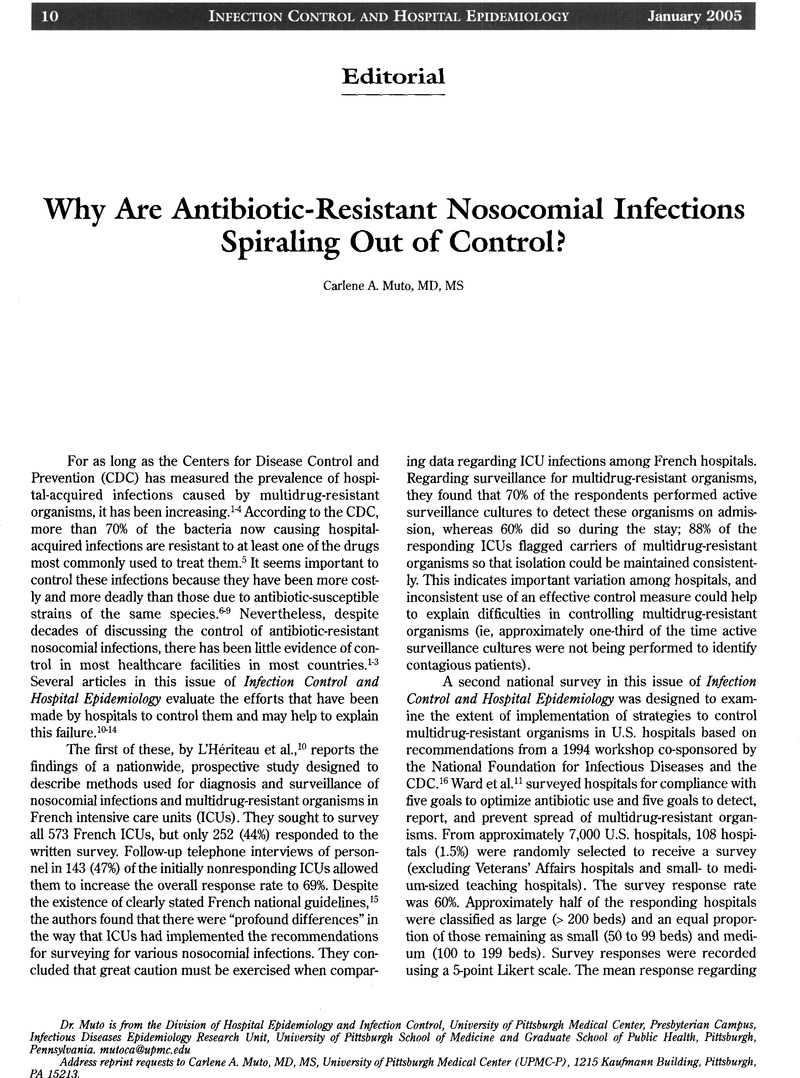Crossref Citations
This article has been cited by the following publications. This list is generated based on data provided by Crossref.
Muto, Carlene A.
2006.
Methicillin-ResistantStaphylococcus aureusControl: We Didn't Start the Fire, but It's Time to Put It Out.
Infection Control & Hospital Epidemiology,
Vol. 27,
Issue. 2,
p.
111.
Douglas Scott II, R
and
Roberts, Rebecca R
2007.
Antimicrobial Resistance: Problem Pathogens and Clinical Countermeasures.
p.
1.
De Angelis, Giulia
Restuccia, Giovanni
Venturiello, Silvia
Cauda, Roberto
Malhotra-Kumar, Surbhi
Goossens, Herman
Schrenzel, Jacques
and
Tacconelli, Evelina
2012.
Nosocomial acquisition of methicillin-resistant Staphyloccocus aureus (MRSA) and extended-spectrum beta-lactamase (ESBL) Enterobacteriaceae in hospitalised patients: a prospective multicenter study.
BMC Infectious Diseases,
Vol. 12,
Issue. 1,
Archibald, Lennox K.
and
McCann, Theresa J.
2014.
Concepts and Methods in Infectious Disease Surveillance.
p.
78.
Wiuff, Camilla
Murdoch, Heather
and
Coia, John E
2014.
Control ofClostridium difficileinfection in the hospital setting.
Expert Review of Anti-infective Therapy,
Vol. 12,
Issue. 4,
p.
457.
Karczewski, Jerzy
Zorman, Julie
Wang, Su
Miezeiewski, Matthew
Xie, Jinfu
Soring, Keri
Petrescu, Ioan
Rogers, Irene
Thiriot, David S.
Cook, James C.
Chamberlin, Mihaela
Xoconostle, Rachel F.
Nahas, Debbie D.
Joyce, Joseph G.
Bodmer, Jean-Luc
Heinrichs, Jon H.
and
Secore, Susan
2014.
Development of a recombinant toxin fragment vaccine for Clostridium difficile infection.
Vaccine,
Vol. 32,
Issue. 24,
p.
2812.
Skally, M.
Duffy, F.
Burns, K.
Doyle, D.
Foley, S.
Thomas, T.
Collins, C.
Smyth, E.
Turton, J.
and
Humphreys, H.
2014.
What may be lurking in the hospital undergrowth? Inapparent cross-transmission of extended-spectrum beta-lactamase-producing Klebsiella pneumoniae.
Journal of Hospital Infection,
Vol. 88,
Issue. 3,
p.
156.
Marti, Elisabet
Variatza, Eleni
and
Balcazar, Jose Luis
2014.
The role of aquatic ecosystems as reservoirs of antibiotic resistance.
Trends in Microbiology,
Vol. 22,
Issue. 1,
p.
36.
Karimzadeh, Iman
Sadeghimanesh, Niloofar
Mirzaee, Mona
and
Sagheb, Mohammad Mahdi
2017.
Evaluating the resistance pattern of gram-negative bacteria during three years at the nephrology ward of a referral hospital in southwest of Iran.
Journal of Nephropathology,
Vol. 6,
Issue. 3,
p.
210.
Shami, Ashwag Y.
2020.
Antimicrobial Resistance Strategies: Are We Approaching the End?.
Journal of Pure and Applied Microbiology,
Vol. 14,
Issue. 1,
p.
93.
Mello, Mariana Sanches de
and
Oliveira, Adriana Cristina
2021.
Overview of the actions to combat bacterial resistance in large hospitals.
Revista Latino-Americana de Enfermagem,
Vol. 29,
Issue. ,





